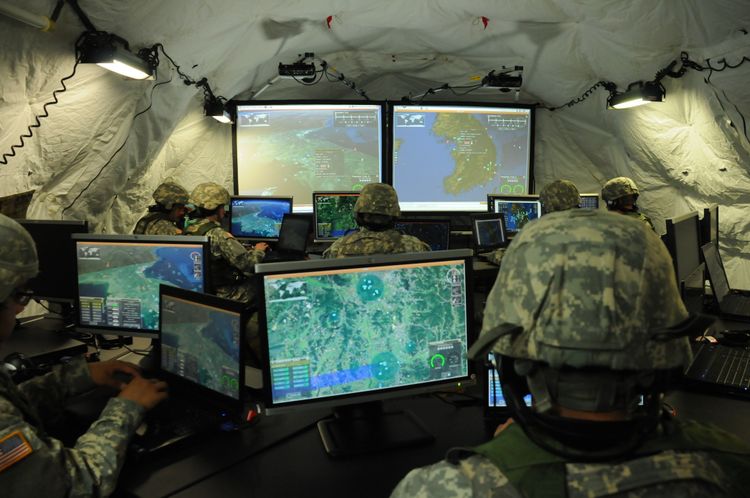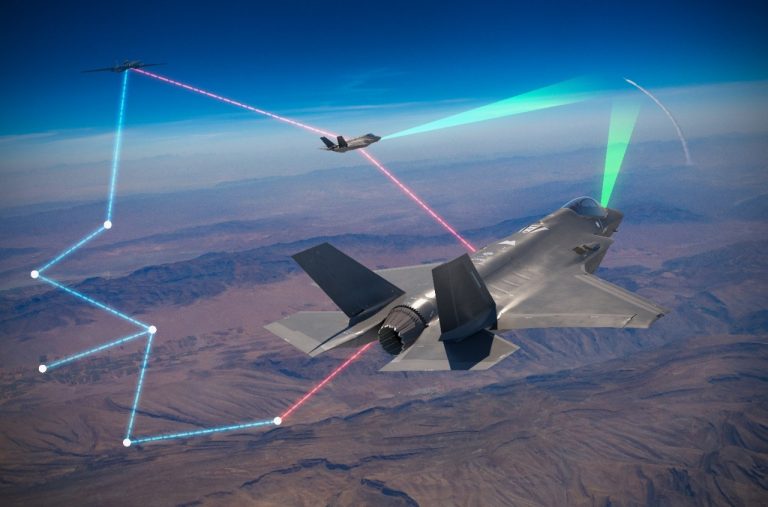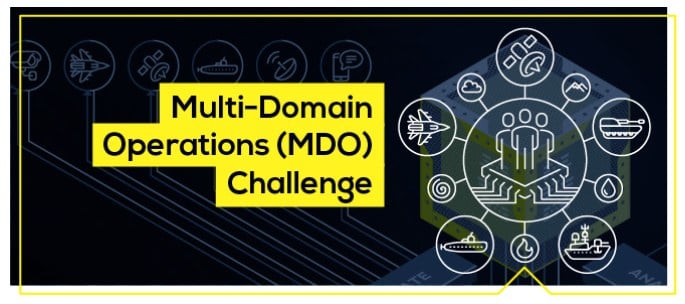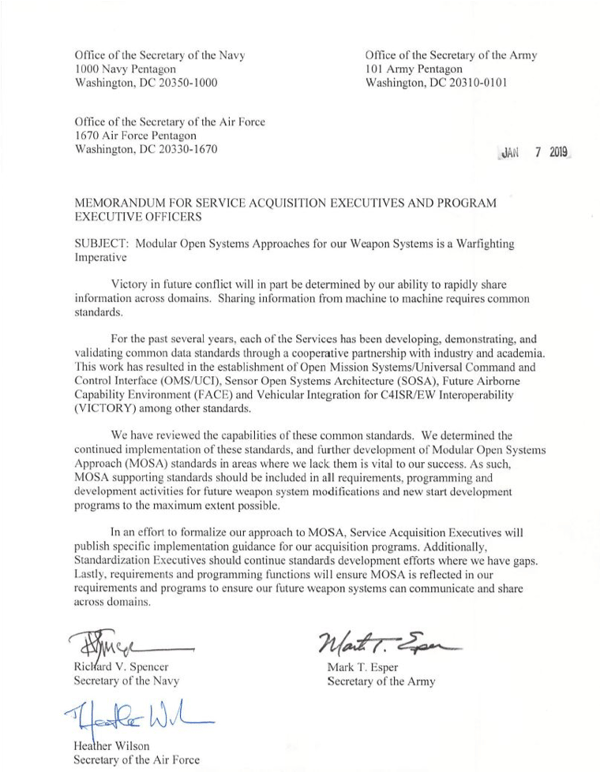7 min read
Multi-Domain Operations: Why DDS is the Right Solution for Securing Critical Data
 Rob Proctor
:
March 5, 2020
Rob Proctor
:
March 5, 2020

**Please note that with the April 2024 release of Connext Professional 7.3 LTS, the functionalities formerly comprising Connext Secure are now available as an optional component to Connext Professional, named Security Extensions.
In a world full of acronyms, some catch on and some don’t. For better or worse, “Internet of Things (IoT)” gained traction early on. But recently, specific industries have become more conscious of drilling deeper into what’s actually going on at the system level, and as a result are coining more accurate terminology to capture the shift in focus. For example, over the last few years in Aerospace and Defense (A&D) circles, a new phrase has emerged: Multi-Domain Operations (MDO).
Already, MDO has been chosen as the theme for defense industry days, as well as challenges from think tanks like AFWERX. Another example of its popularity is the fact that an entire blog site devoted to MDO has sprung up, where various US Department of Defense (DoD) academics and officers opine at length on the topic. A&D primes have landing pages about MDO, and some even weave MDO into their design win announcements.

Figure 1: Integrated Air and Missile Defense (IAMD) Battle Command System (IBCS) is an example of a MDO system
Judging from the direction the DoD is heading, MDO is clearly on the right road. Recently, the Air Force Chief of Staff Gen. David L. Goldfein announced that MDO is ‘the single most critical’ tool for winning future high-end fights. Bottom line: MDO is a phrase and concept that is here to stay. And for teams tasked with building a comprehensive system for MDO, there is currently no better way to manage, distribute and secure the data that enables MDO than RTI Connext DDS.
Defining MDO
As with the term IoT, opinions vary as to what exactly MDO is. But most agree on the general concept: MDO is the integration of capabilities across multiple domains (such as air, sea, land, space, cyber and information assets) in order to achieve desired operational effects. Lockheed Martin Corporation (LMCO) describes it as, “A new warfighting concept ... By synchronizing major systems and crucial data sources with revolutionary simplicity, Multi-Domain Operations provides a complete picture of the battlespace and empowers warfighters to quickly make decisions that drive action.”

Figure 2: Multi-Domain Operations (MDO) [Image source: LMCO MDO webpage]
Your Systems, Working as One
According to the previously-referenced USAF article, defining MDO and putting it into practice is the challenge. This requires instilling a new culture that moves thinking away from a single “platform” focus, to creating a highly connected, agile and resilient system. It refines the familiar command chain to heavier use of artificial intelligence and machine learning that yields better options faster. As Goldfein explained in his speech to the Air Chiefs, it means creating a system where “people are on the loop, not in the loop.”
Today’s connected systems must work as one system-of-systems. The days of single-vendor, stove-piped, proprietary, federated systems are over. Using the OMG® Data Distribution Service™ (DDS) Standard to integrate the flow of data between systems, it is possible to achieve a truly integrated system working as one. Real-Time Innovations (RTI) is a software company that believes in the importance of this concept so strongly that we made it our tagline long ago.
Achieving MDO with Connext DDS Secure
Earlier, I mentioned the AFWERX MDO challenge. A major component of this challenge is the section that calls for “Real-Time Global Secure Communication.” The term Real-Time Global Secure Communication is in many ways applicable to what we’re doing. It could literally be a description of the DDS Standard and Connext DDS Secure, because right out of the box, Connext DDS Secure provides for all of the capabilities described in the Real-Time Global Secure Communication section of the AFWERX MDO challenge.

Figure 3: AFWERX MDO Challenge
Real-Time Global Secure Communication
In this section, we align the descriptions of the AFWERX MDO challenge to the capabilities of Connext DDS Secure, one step at a time:
AFWERX MDO Challenge: “Applications that allow missions to be executed flawlessly by feeding data to operators in real time that is relevant to the individual context of each person and is updated continuously as the mission progresses.”
Connext DDS Solution: We already know that Connext DDS offers data at real-time speeds over a variety of transports. But Connext DDS can also filter that data at run time with Content Filtered Topics so that data readers only get the data that they need, when they need it. For example, if you are interested in radar tracks from friendly forces above 10,000 feet moving away from your position, subscribe to that radar with those filters and that’s exactly what you’ll see. But if you want to change that radar filter to track any moving object below 5,000 feet moving towards you, simply change the content filter and then you will only receive the new type of data. You can even change the frequency of the samples that each data reader will receive. If that radar system is putting out data reliably at 20 kHz, and you do not need that many samples per second, you can choose how many to get. Better still is that different data readers can subscribe to the same radar system with different content filters and different Qualities of Service (QoS) to get different real-time data that is relevant to the individual context for each data reader.
AFWERX MDO Challenge: “All MDO components must be designed to facilitate security without compromising the ability of various people and systems to collaborate. Components that address security specifically may address authorization, access, threat identification and mitigation. Other security functions that are essential include managing multiple levels of security and facilitating access to information across domains while enforcing security standards for each type of source data and information products that combine data from multiple sources.”
Connext DDS Secure Solution: From a security standpoint, the DDS - Secure Standard address this head on. Connext DDS Secure won’t allow for spoofing of data because each participant must authenticate to the network. Connext DDS Secure provides the ability to assign participants different role-based access to certain topics of data. In other words, if you are not allowed to see data from that radar system in the first place, the system will not share it with you, even if you have authentication to the network itself. Each topic of data can be encrypted (or not) as the system designers see fit. Data Tagging for threat identification and Data Logging for After Action Reviews are all standard components of Connext DDS Secure. Connext DDS Secure is also capable of having different domains for different security levels that use the same network.

Figure 4: An MDO view from a recent RTI simulation SBIR win to study distributed wargaming over DDS
AFWERX MDO Challenge: “Data may need to be transported across the globe and cached in locations close to where it is needed.”
Connext DDS Solution: Connext DDS has the ability to persist data on either the writer side or on the reader side cache via its persistence service. Persistence Service is a Connext DDS application that saves DDS data samples to transient or permanent storage, so they can be delivered to subscribing applications that join the system at a later time, even if the publishing application has already terminated. When configured to run in PERSISTENT mode, Persistence Service can use the filesystem or a relational database that provides an ODBC driver. For each persistent topic, it collects all the data written by the corresponding persistent DataWriters and stores them into persistent storage on either the data reader or data writer side, or both.
AFWERX MDO Challenge: “The data management systems must limit data duplication while maximizing performance and resiliency.”
Connext DDS Solution: One need look no further than the DDS QoS known as OWNERSHIP. OWNERSHIP is really a property that is shared between DataReaders and DataWriters of a Topic. However, in any MDO system, some Topics will be exclusively owned and others will be shared. System requirements will determine which are which. In a different part of the system, EXCLUSIVE OWNERSHIP may be used to implement redundancy in support of fault tolerance. One way to implement fault tolerance is to create the system redundantly both in hardware and software. If a piece of the running system fails, a backup can take over. In systems where failover from the primary to backup system must be seamless and transparent, the actual mechanics of failover must be fast, and the redundant component must immediately pickup where the failed component left off.
For the network connections of the component, Connext DDS can provide redundant DataWriter and DataReaders. In this case, you would not want the DataReaders to receive redundant messages from the redundant DataWriters. Instead, you will want the DataReaders to only receive messages from the primary application and only from a backup application when a failure occurs.
MDO Through Modular Open Systems Approach
MDO is the way forward for globally distributed systems. However, there is another requirement for all new DoD systems, especially for systems that will be part of Multi-Domain Operations. Last year, a rare tri-service acquisition memorandum signed by all three Secretaries of the U.S. Armed Services directed that all future systems must adhere to a Modular Open Systems Approach (MOSA). It classified this approach as a warfighting imperative. According to the memorandum, “Victory in conflict will in part be determined by our ability to rapidly share information across domains”. Specifically, the memorandum cites several existing interoperability standards “as vital to our success”.

Figure 5: The tri-service memorandum that calls for MOSA in MDO (source: US Department of Defense)
This is a logical (and long overdue) move for the DoD, and it dovetails nicely with the MDO mandate. If you are going to have distributed disparate systems participate in a Multi-Domain Operation, you need to have the individual subsystems be built against open interoperability standards so that joint operations can happen readily. Plug and Play for these systems is vital since there will be many variations of Multi-Domain Operations systems that will need to communicate in real warfighting scenarios.
Fortunately, RTI Connext DDS is already conformant with MOSA standards today! If MOSA truly is a requirement, you have a ready-to-go solution today with RTI Connext DDS, a TRL-9 COTS product that meets the data demands for MDO.
Connext DDS is the Right Solution for MDO
The power of Multi-Domain Operation is the data itself. Mission-critical data with unique security needs must get to where it needs to be in a secure and timely way in order to avoid disastrous consequences. The interoperability between these domains also needs to be MOSA-conformant. The AFWERX MDO Challenge states, “Solutions demonstrating interoperability between disparate systems on a global scale are essential for automating MDO processes. Frameworks that enable interoperability with minimal skill requirements, high security and the ability to adapt when systems fail are viewed as an essential component of an automated MDO system.”
Personally, I could not agree more. And the good news is that there is a solution available today to meet these rigorous security, time sensitive and scalable data interoperability requirements. Proven in hundreds of deployed systems, Connext DDS is perfectly suited to meet the requirements of MDO to ensure that future weapon systems can communicate and share data across domains.
For more information and to learn more about MDO, visit with RTI at the Army Aviation Mission Solution Summit and at the NDIA Joint Armaments and Robotics Conference & Exhibition.
(Main blog Image source: US Air Force)
About the author:
 Rob Proctor is a Lead Field Application Engineer for Real-Time Innovations. He has over 24 years of experience in A&D Embedded Software as a Software Engineer and Field Applications Engineer. Prior to his time as a Field Application Engineer, he developed and implemented real time embedded software at major Aerospace and Defense Corporations. His roles have included developing software and system designs, mission-management and display processing systems. Rob received his BS from Embry-Riddle Aeronautical University in Aerospace Studies and his MS from the University of South Florida in Engineering Management.
Rob Proctor is a Lead Field Application Engineer for Real-Time Innovations. He has over 24 years of experience in A&D Embedded Software as a Software Engineer and Field Applications Engineer. Prior to his time as a Field Application Engineer, he developed and implemented real time embedded software at major Aerospace and Defense Corporations. His roles have included developing software and system designs, mission-management and display processing systems. Rob received his BS from Embry-Riddle Aeronautical University in Aerospace Studies and his MS from the University of South Florida in Engineering Management.
Posts by Tag
- Developers/Engineer (177)
- Connext DDS Suite (77)
- Technology (74)
- News & Events (73)
- 2020 (54)
- Standards & Consortia (51)
- Aerospace & Defense (48)
- Automotive (35)
- 2023 (34)
- 2022 (29)
- IIoT (27)
- Leadership (24)
- 2024 (22)
- Cybersecurity (20)
- Healthcare (20)
- 2021 (19)
- Connectivity Technology (16)
- Military Avionics (15)
- Culture & Careers (14)
- FACE (13)
- Connext DDS Pro (10)
- JADC2 (10)
- ROS 2 (10)
- 2025 (8)
- Connext DDS Tools (7)
- Connext DDS Micro (6)
- Databus (6)
- Transportation (5)
- Case + Code (4)
- Connext DDS (4)
- Connext DDS Cert (4)
- Energy Systems (4)
- FACE Technical Standard (4)
- Oil & Gas (3)
- RTI Labs (3)
- Research (3)
- Robotics (3)
- #A&D (2)
- Connext Conference (2)
- Edge Computing (2)
- MDO (2)
- MS&T (2)
- TSN (2)
- ABMS (1)
- C4ISR (1)
- ISO 26262 (1)
- L3Harris (1)
- LabView (1)
- MathWorks (1)
- National Instruments (1)
- Simulation (1)
- Tech Talks (1)
- UAM (1)
- Videos (1)
- eVTOL (1)
 Success-Plan Services
Success-Plan Services